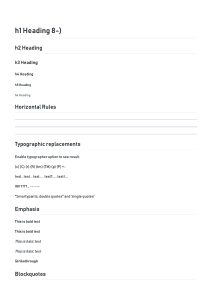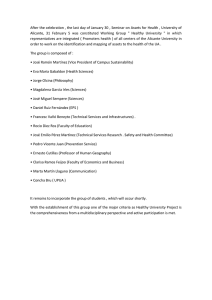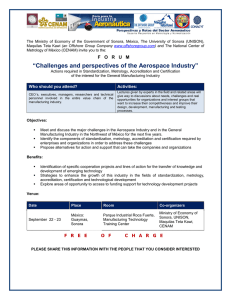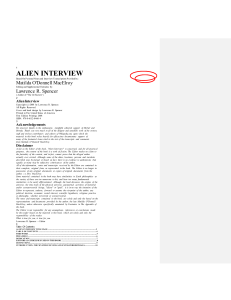Personnel of El Banco de Sonora
Anuncio
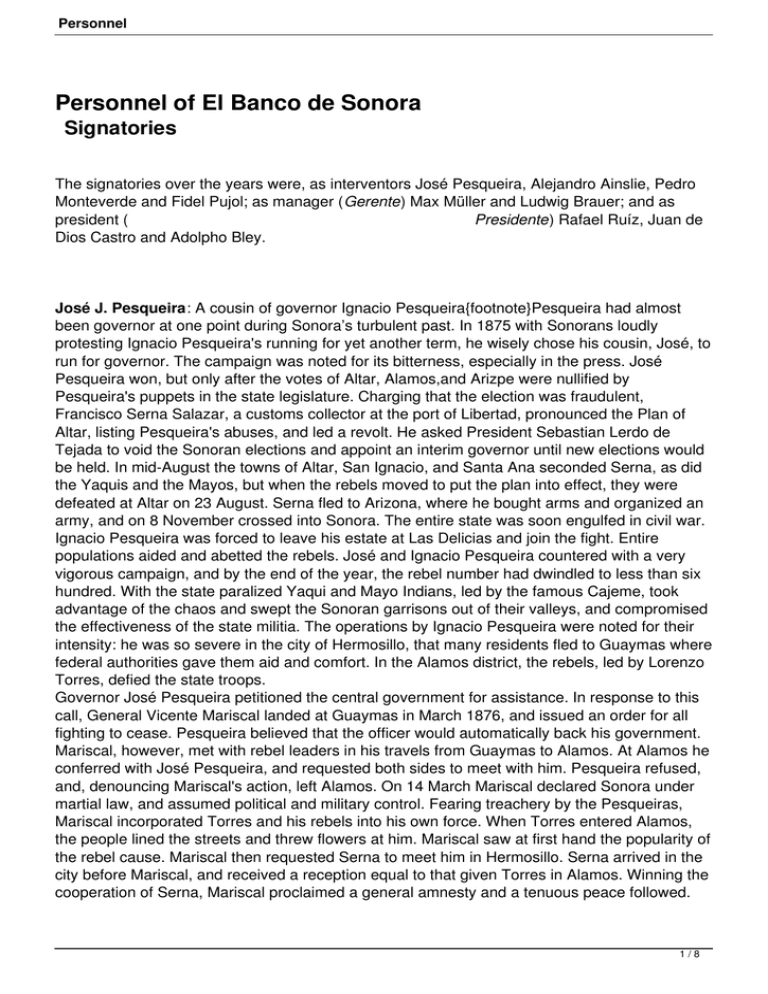
Personnel
Personnel of El Banco de Sonora
Signatories
The signatories over the years were, as interventors José Pesqueira, Alejandro Ainslie, Pedro
Monteverde and Fidel Pujol; as manager (Gerente) Max Müller and Ludwig Brauer; and as
president (
Presidente) Rafael Ruíz, Juan de
Dios Castro and Adolpho Bley.
José J. Pesqueira: A cousin of governor Ignacio Pesqueira{footnote}Pesqueira had almost
been governor at one point during Sonora’s turbulent past. In 1875 with Sonorans loudly
protesting Ignacio Pesqueira's running for yet another term, he wisely chose his cousin, José, to
run for governor. The campaign was noted for its bitterness, especially in the press. José
Pesqueira won, but only after the votes of Altar, Alamos,and Arizpe were nullified by
Pesqueira's puppets in the state legislature. Charging that the election was fraudulent,
Francisco Serna Salazar, a customs collector at the port of Libertad, pronounced the Plan of
Altar, listing Pesqueira's abuses, and led a revolt. He asked President Sebastian Lerdo de
Tejada to void the Sonoran elections and appoint an interim governor until new elections would
be held. In mid-August the towns of Altar, San Ignacio, and Santa Ana seconded Serna, as did
the Yaquis and the Mayos, but when the rebels moved to put the plan into effect, they were
defeated at Altar on 23 August. Serna fled to Arizona, where he bought arms and organized an
army, and on 8 November crossed into Sonora. The entire state was soon engulfed in civil war.
Ignacio Pesqueira was forced to leave his estate at Las Delicias and join the fight. Entire
populations aided and abetted the rebels. José and Ignacio Pesqueira countered with a very
vigorous campaign, and by the end of the year, the rebel number had dwindled to less than six
hundred. With the state paralized Yaqui and Mayo Indians, led by the famous Cajeme, took
advantage of the chaos and swept the Sonoran garrisons out of their valleys, and compromised
the effectiveness of the state militia. The operations by Ignacio Pesqueira were noted for their
intensity: he was so severe in the city of Hermosillo, that many residents fled to Guaymas where
federal authorities gave them aid and comfort. In the Alamos district, the rebels, led by Lorenzo
Torres, defied the state troops.
Governor José Pesqueira petitioned the central government for assistance. In response to this
call, General Vicente Mariscal landed at Guaymas in March 1876, and issued an order for all
fighting to cease. Pesqueira believed that the officer would automatically back his government.
Mariscal, however, met with rebel leaders in his travels from Guaymas to Alamos. At Alamos he
conferred with José Pesqueira, and requested both sides to meet with him. Pesqueira refused,
and, denouncing Mariscal's action, left Alamos. On 14 March Mariscal declared Sonora under
martial law, and assumed political and military control. Fearing treachery by the Pesqueiras,
Mariscal incorporated Torres and his rebels into his own force. When Torres entered Alamos,
the people lined the streets and threw flowers at him. Mariscal saw at first hand the popularity of
the rebel cause. Mariscal then requested Serna to meet him in Hermosillo. Serna arrived in the
city before Mariscal, and received a reception equal to that given Torres in Alamos. Winning the
cooperation of Serna, Mariscal proclaimed a general amnesty and a tenuous peace followed.
1/8
Personnel
Ignacio Pesqueira returned to Las Delicias to await an opportunity to depose the rebels.
Events in Mexico City brought a change in power which emboldened the Pesqueiras to attempt
a comeback. Lerdo de Tejada was reelected for another term, but in October 1876, Porfirio Diaz
revolted again and two months later was president of Mexico. José Pesqueira rushed to Las
Delicias, conferred with Ignacio, and sent a communique to Mariscal. Because of the change in
government, he said, Mariscal’s commission had expired and the executive power had reverted
to him. He demanded that Mariscal recognize his legitimacy. On 19 December José Pesqueira
declared Mariscal's claim to governorship null and void and himself governor. However, the
Pesquieras were unable to raise their supporters and six months later Mariscal was elected
governor of Sonora.{/footnote}, he was interventor from the bank’s inauguration until September
1902, when he had to give up the post because of a scandal. On 1 August 1902 Alejandro
Ainslie, the Sonoran attorney general (Ministro Fiscal) wrote to José Limantour, the Secretario
de Hacienda, to inform him that Pesqueira had been accused before the judicial authorities in
Arizpe of rustling (abigeato). Since it might be necessary to replace Pesquiera, Ainslie asked
Limantour for the position. On 12 August Limantour acknowledged his letter and said he would
put in a good word with President Díaz{footnote}CONDUMEX, Colección José Y. Limantour,
carpeta 19, lejago 1{/footnote}.
In the beginning Pesqueira signed the notes by hand but on 18 March 1898 he wrote to the
Minister of Finance, José Y. Limantour, that he wanted to take advantage of the ability to sign
$5 and $10 notes in facsimile and asked him to arrange for the Oficina del Timbre to make a
plate{footnote}CONDUMEX, Colección José Y. Limantour, carpeta 40, legajo 10563{/footnote}.
Alejandro D. Ainslie: He became interventor in September 1902 (his signature is on $20 and
$50 notes dated 1 July 1902 but these must have been issued later) and gave up the post in
November 1904. Probably a solicitor, he served as attorney general (Ministro Fiscal) of Sonora
and editor of
La Constitución, the official bulletin of the state. He left
Sonora to take up a federal post in Mexico City, and in 1914 became the Huertista
government’s consul in Tucson{footnote}
The
Oasis
, 29 August 1914{/footnote}.
Pedro Monteverde: He took over as interventor in January 1905 (though his signature appears
on notes dated 1 July 1903 and 15 November 1904) and held the office until August 1911. Born
on 18 October 1834, he was a lawyer, magistrate, and judge who served as local Deputy and
Secretario de Gobierno. He died in Los Angeles on 29 April 1915.
Fidel S. Pujol: He was interventor from September 1911. A lawyer, public notary and judge
2/8
Personnel
from Guaymas, Pujol was also involved in journalism from an early age and edited
La Baja California
,
El Orden
,
La Linea Recta
and
El Criterio Público
. All the notes that he signed had the printed date 2 January 1911.
Max Müller: Müller was born in Lübeck, Germany, in 1865 and got his early training in banking
in his home country. He became manager of the El Paso National Bank in Paso del Norte in
October 1889, and after five years started a private banking firm there under the name Farrell &
Müller. In 1897 the owners sold out their business and Müller became the first manager of the
Banco de Sonora. He held the post from the bank’s inauguration until (?) September 1908,
when he took over as president. In 1912 and 1913 he appears as vice-president. Müller was
also German consul in Hermosillo and president of the Espiritu Mexican Mining Company.
Ludwig Brauer: was also of German birth and received his early training and connection with
banking in Germany. He was manager from September 1908 until at least November 1912 and
was president until June 1913 when he handed over to Adolpho Bley.
Rafael J. Ruíz: He was the bank’s first president. Born in Alamos he commenced his business
career in Guaymas and in 1880 he established the ‘La Fama’ store in Hermosillo. Ruiz had
been involved in the first attempt to establish a state bank in 1881. He died in 1909 at the age of
sixty-six.
Juan de Dios Castro: He was the bank’s first vice-president and had taken over the presidency
by March 1901 (the earliest note signed by de Dios Castro is a $20 dated 1 February 1900). He
handed over the office in 1908, stepping down fron the board at the Annual General Meeting on
16 February 1908. Listed in 1867 as one of the richest men in Guaymas{footnote}
La Estrella de Occidente
, 28 June 1867{/footnote}, in 1860 he had founded the wholesale and retail business of ‘Esquina
Redonda’. He carried ‘a full and complete line of all grades of chinaware and crockery,
silverware, furniture, of the most expensive as well as cheaper grades, hats of all shapes and
styles, blankets, leather, as well as one of the finest lines of gent’s furnishing goods in the state
of Sonora’{footnote}J. R. Southworth, El Estado de Sonora. Sus Industrias, Comerciales, Mineras y Manufactureras
3/8
Personnel
, Nogales, Arizona, 1897{/footnote}. The store also provided banking facilities: ‘Mr. Castro,
through his excellent connections with the banking fraternity in the United States, is enabled to
buy and sell American gold, greenbacks, drafts on San Francisco and New York on best terms
obtainable’.
Adolfo Bley: Adolfo Bley was a director in 1900, made vice president by March 1901 and
president in March 1908{footnote}
Tucson Daily Citizen, 9 March 1908{/footnote}.
He was president again from 10 January 1913.
Adolfo Bley was born in 1864. The two Bley brothers, Adolfo and Simon, were natives of
Germany but came to Sonora in 18[ ]. By 1892 Adolfo was a partner in the firm of Seldner and
Borstel whilst Simon was running the Hermosillo branch. On 1 January 1893 they bought out
the branch and set themselves up as ‘Bley Hermanos’. The stock carried embraced ‘everything
in the line of light and heavy hardware, mining machinery and supplies, agricultural machinery
and implements, glassware, crockeryware, granite, ironware, a full line of groceries, wines and
liquors, etc’{footnote}ibid. Also known as Merceria de la Paz, on calle Lerdo and Tampico (now
avenida Obregón){/footnote}. During the revolution Bley moved to the United States but he was deported during the First
World War as an enemy alien. He had been in Hermosillo on a business trip and crossed the
line at Nogales, en route to his home in San Francisco, on 19 December 1917 but was returned
to Mexico{footnote}El Paso Herald, 20 December 1917: San Francisco Chronicle, 21
December 1917{/footnote}. He returned to the States after the armistice and became a
prominent merchant. He died in San Francisco on 16 November 1930{footnote}
The New York Times
, 18 November 1930{/footnote}.
Other personnel
Other people connected with the bank included the following. In all enough of them (Ainslie,
Bley, Müller, and many of the employees) were Germans for the bank to be considered
German-owned{footnote}Osco Castañeda Dahes, La Revolución Mexicana, Mexico,
1989{/footnote}.
Victor Aguilar: He was elected comisario at the first shareholders' meeting in November
1897{footnote}
Dos Republicas, California, 6
November 1897{/footnote} and was a director in [ ]
4/8
Personnel
Henry Bartning: He was manager of the Nogales branch for several years, then moved to the
Alamos and finally the Culiacán branch{footnote}
The Oasis, 21 March
1914{/footnote}.
Ricardo Cubillas: He was the bank’s assistant auditor in [ ].
Juan C. Dorbecker: He covered as interventor in July 1900.
Felix Epler Farrell: He was born in Jacksonville, Illinois on 28 October 1868. After a spell at the
First National Bank of Jacksonville he went to Ciudad Juárez, where, in 1893, he established
the private banking firm of Farrell & Müller. In December 1897 the owners sold their interests to
the Banco Minero and Farrell moved to Hermosillo, where he assisted in the establishment of
the Banco de Sonora. In the spring of 1898 he disposed of his interests and returned to
Jacksonville to become Assistant Cashier of the First National.
George Grünig: Born in Darmstadt, Germany, in 1869 he came to Sonora in 1896 and
established the brewery Cervecería de Sonora. He married Dolores Monteverde, the daughter
of Pedro Monteverde{footnote}information courtesy of Nicholas Juliano. Pedro Monteverde
married Juliana Uruchurtu and had two daughters, Amelia and Dolores. Dolores (born 1
January 1874, died San Francisco 27 October 1914) married George Grünig{/footnote}. He was
on the board of directors by February 1908.
John (Juan) Ashton Heap: Heap, who also served as the British consul in Guaymas, was the
manager at Guaymas from [ ] until early 1912 when he resigned in order to devote more time
to other business affairs{footnote}
Tucson Daily Citizen, 24 July
1912. Photograph courtesy of Alexander Heap{/footnote}. By June 1914 Heap was vice
president of the Blochman Commercial and Savings bank of San Diego, and travelling in
Sonora on behalf of the bank{footnote}
Tucson Daily Citizen
, 3 June 1914. The Blochman bank specialized in handling Mexican exchange, and did
business with both Huerta (in June 1914 transferring 100,000 pesos from Mexico City to
Federal troops at Ensenada) and the Constitutionalists.{/footnote}.
5/8
Personnel
J. M. Hernández: He signed the bank’s balance sheets as acting accountant (contador) in May
1908 and acting cashier (
cajero
) in August and September 1910 and as
contador
in October 1910.
Jorge Le Brun: He was the bank’s auditor in [ ].
Manual I. Loaiza: elected alternate director (Suplente) at the first shareholders' meeting in
November 1897{footnote}
Dos Republicas
, California, 6 November 1897{/footnote}.
F. Lopez del Castillo: He was a director in [ ]
Alberto Mascareñas Navarro: The son of Manuel Macareñas, he was born in Guaymas in
1876. He began his banking career with the Banco de Sonora as subgerente in its Chihuahua
branch and then managed its Nogales branch. He was cashier of the Banco Hipotecario y
Agricola del Pacifico at Hermosillo, and then in 1913 set himself up in business in
Nogales{footnote}
The Oasis, 15 February 1913{/footnote}. He
entered the diplomatic corps in 1918 as Mexican Consul General in San Francisco, then moved
to Havana, London and Liverpool, ending up as Consul General in New York. In December
1924 he was recalled to Mexico by President Calles to be Subsecretario de Hacienda, under
Finance Minister Alberto J. Pani. As manager of the Comisión Monetaria, he was active in the
founding of the Banco de México on 1 September 1925, and served as its first managing
director. After leaving the bank in 1938 he was a minister plenipotentiary in London, and died in
Mexico City in 1944.
Luis A. Martinez: He was vice-president in 1913, when the bank’s directors were based in Los
Angeles.
Alfredo May: He was a director in [ ].
6/8
Personnel
Rudolf E. H. Petersen: He was born in Lübeck, Germany on 9 March 1889 and was married to
Eva Grünig, the daughter of George Grünig. He occasionally acted as
co
ntador
in 1911 and 1912 and was manager of the Hermosillo branch in 1913. In June 1917 he was
clerk for the
Sonora Bank & Trust Company
in Nogales, Arizona and interned as an alien enemy{footnote}information courtesy of Nicholas
Juliano. George Grünig married Dolores Monteverde, the daughter of Pedro Monteverde, and
had three children, Eva, Amelia and George. Eva married Petersen{/footnote}.
Lauro Quiróz: He was the bank’s assistant auditor in [ ].
Carlos Rivera: He was manager of the Nogales branch in 1912{footnote}Polk's Arizona
Pictorial Gazetteer And Business Directory
, 1912{/footnote} and continued as manager and cashier of the
Sonora Bank & Trust Company
{footnote}
Tucson Daily Citizen
, 23 May 1914{/footnote}.
Harry J. Smith: Formerly of El Paso, he was contador in 1900 until at least 1912 and
represented the bank’s interests in Hermosillo in 1915.
Alejandro F. Tarín: He was cajero in 1900 till at least September 1913.
Gustavo Torres: elected alternate director (Suplente) at the first shareholders' meeting in
November 1897{footnote}
Dos Republicas,
California, 6 November 1897{/footnote}.
W. C. Winegar: in February 1902 Winegar was teller for the newly established Banco de
Cananea
{footn
ote}
Tu
7/8
Personnel
cson Daily Citizen
, 28 February 1902{/footnote} and by 1904 was working for the First National Bank of Douglas,
in charge of their Mexican interest{footnote}
Bisbee Daily Review
, 2 September 1904{/footnote}. He became manager of the Chihuahua branch on 17 August
1906{footnote}
El Correo de Sonora
, 17 August 1906{/footnote}. In October 1913 Silvestre Terrazas recommended Winegar to
Villa, mentioning that he was almost the only banker in the city who had supported their cause
and saying that he might need protection if the others tried to take revenge when they saw
they had lost{footnote}ST papers, Part I, box 83, 19 October 1913{/footnote}. At the outbreak of
the revolution Winegar moved to El Paso, worked as manager of the
Sonora Bank & Trust Company
, and then took up residence in Los Angeles. In April 1935 he was manager of the Banco
Nacional in Ciudad Juárez.
8/8
